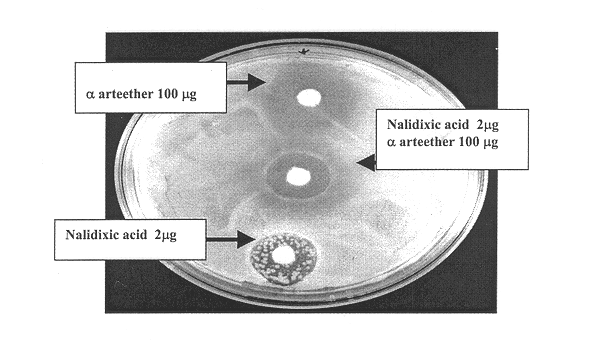Anti-microbial composition and method for producing the same
- Summary
- Abstract
- Description
- Claims
- Application Information
AI Technical Summary
Benefits of technology
Problems solved by technology
Method used
Image
Examples
example 2
Monitoring Emergence of .alpha.-arteether.sup.r mutants.
Further to determine the frequency of spontaneous resistant mutants in Escherchia coil and Mycobacterium smegmatis for .alpha.-arteether, the applicants used the nalidixic acid resistant mutants from the earlier example as the wild type strains since those were sensitive to .alpha.-arteether to isolate .alpha.-arteether resistant colonies. Known titers of broth cultures of the mutant (Nal) bacteria were diluted and plated in petriplates containing 1000 .mu.g / ml .alpha.-arteether, and the resistant colonies thus developed were counted to determine the frequencies (Table 2).
example 3
Counter-action Study of Nalidixic Acid and .alpha.-arteether in Combination Against Resistant Mutants of Each Other.
Upon plating the broth cultures on combination poison agar, no resistant colonies were detected for either of the resistant mutants i. e. for nalidixic acid and .alpha.-arteether separately or together, when grown in presence of 50 .mu.g / ml Nalidixic acid and 1000 .mu. / .alpha.-arteether.
Since pathogens always try to counter the drug by genetically modifying itself through mutation(s) in the region of the drug target gene, it is necessary to kill those mutant(s) resistant cells for effective drug management. With this rationale, the applicants evaluated a selected drug resistant mutant strain (Ml) for nalidixic acid (wild type strains being sensitive to nalidixic acid). This mutant strain developed from wild type was defective in Gyr A subunit confirmed by mobilizing a plasmid bearing a wild type gyr A gene. Interestingly the gyr A.sup.- mutant developed from the wild t...
example 4
Correlation Between Levels of Counter Resistance and Sensitivity
To determine the correlation between nalidixic acid and .alpha.-arteether sensitivity, the applicants selected Escherchia coli cultures which were resistant to nalidixic acid at varying degrees (concentrations). Based on the minimal inhibitory concentration of nalidixic acid, Escherchia coli mutants were grouped as highly sensitive (MIC less than or equal to 10 .mu.g / ml), resistant (MIC 10 to 200 .mu.g / ml), highly resistant sensitive (MIC more than or equal to 200 .mu.g / ml). These strains were then tested for their sensitivity against .alpha.-arteether by estimating their growth (Absorbance at 620 nano meter wavelength of light) in presence of increasing concentrations of .alpha.-arteether. The absorbance data was converted to percent growth by considering the absorbance in control as 100%. The growth was then quantified as follows: 1.) greater than 80% growth : the mutant is highly resistant to .alpha.-arteether; 2.) 2...
PUM
| Property | Measurement | Unit |
|---|---|---|
| Mass | aaaaa | aaaaa |
| Mass | aaaaa | aaaaa |
| Volume | aaaaa | aaaaa |
Abstract
Description
Claims
Application Information
 Login to View More
Login to View More - R&D
- Intellectual Property
- Life Sciences
- Materials
- Tech Scout
- Unparalleled Data Quality
- Higher Quality Content
- 60% Fewer Hallucinations
Browse by: Latest US Patents, China's latest patents, Technical Efficacy Thesaurus, Application Domain, Technology Topic, Popular Technical Reports.
© 2025 PatSnap. All rights reserved.Legal|Privacy policy|Modern Slavery Act Transparency Statement|Sitemap|About US| Contact US: help@patsnap.com

